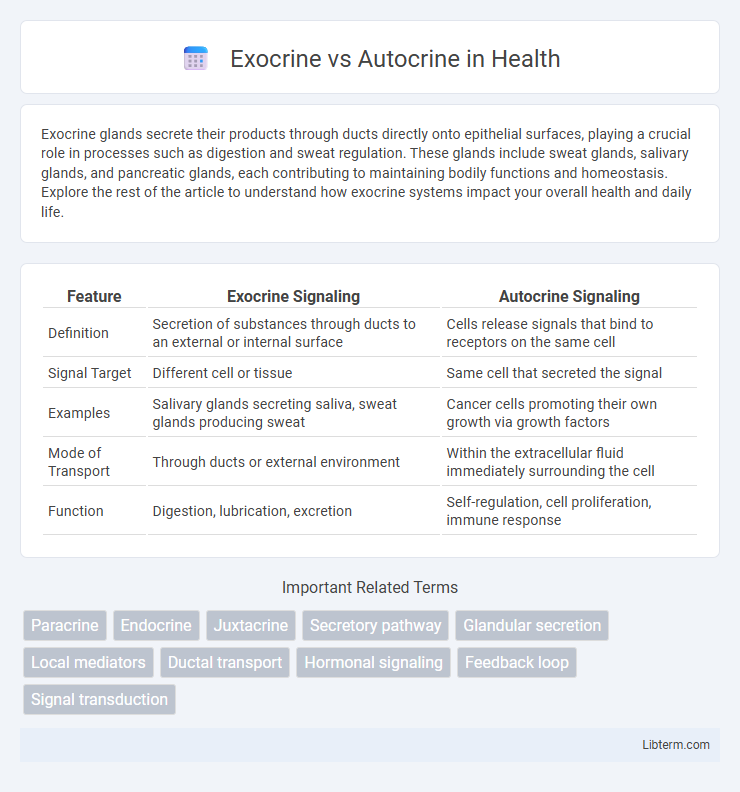Exocrine glands secrete their products through ducts directly onto epithelial surfaces, playing a crucial role in processes such as digestion and sweat regulation. These glands include sweat glands, salivary glands, and pancreatic glands, each contributing to maintaining bodily functions and homeostasis. Explore the rest of the article to understand how exocrine systems impact your overall health and daily life.
Table of Comparison
| Feature | Exocrine Signaling | Autocrine Signaling |
|---|---|---|
| Definition | Secretion of substances through ducts to an external or internal surface | Cells release signals that bind to receptors on the same cell |
| Signal Target | Different cell or tissue | Same cell that secreted the signal |
| Examples | Salivary glands secreting saliva, sweat glands producing sweat | Cancer cells promoting their own growth via growth factors |
| Mode of Transport | Through ducts or external environment | Within the extracellular fluid immediately surrounding the cell |
| Function | Digestion, lubrication, excretion | Self-regulation, cell proliferation, immune response |
Introduction to Cell Signaling Mechanisms
Exocrine signaling involves the secretion of signaling molecules through ducts to target cells located at a distance, commonly seen in glands releasing enzymes or sweat. Autocrine signaling occurs when cells release signals that bind to receptors on their own surface, regulating processes such as cell growth and immune responses. Both mechanisms play critical roles in maintaining cellular communication and homeostasis within multicellular organisms.
Defining Exocrine Signaling
Exocrine signaling involves the secretion of signaling molecules through ducts to a specific external or internal surface, such as sweat glands releasing sweat onto the skin or digestive glands secreting enzymes into the gastrointestinal tract. This form of signaling targets cells at a distance from the gland, differing from autocrine signaling where cells respond to signals they release themselves. Exocrine signaling plays a critical role in processes like digestion and thermoregulation by delivering substances directly to localized areas.
Understanding Autocrine Signaling
Autocrine signaling involves cells secreting signaling molecules that bind to receptors on their own surface, enabling self-regulation and rapid response to environmental changes. This mode of communication plays a critical role in immune responses, cancer progression, and tissue development by modulating cellular activities such as growth, differentiation, and apoptosis. Unlike exocrine signaling, which targets distant cells via ducts or bloodstream, autocrine signaling operates locally and directly within the same cell or nearby identical cells.
Key Differences Between Exocrine and Autocrine
Exocrine signaling involves the secretion of substances like enzymes or sweat through ducts to external or internal surfaces, affecting distant target cells, while autocrine signaling occurs when cells release signaling molecules that bind to receptors on their own surface, influencing themselves. Exocrine glands include sweat glands and salivary glands, functioning in processes such as digestion and thermoregulation, whereas autocrine signaling plays a crucial role in immune responses and cell growth regulation. The fundamental difference lies in the transmission pathway: exocrine signals travel through ducts to reach target cells, whereas autocrine factors act locally on the same cell that secreted them.
Major Examples of Exocrine Processes
Exocrine processes involve the secretion of substances through ducts to external or internal surfaces, with major examples including sweat glands releasing sweat for thermoregulation and salivary glands producing saliva to begin digestion. Pancreatic exocrine cells secrete digestive enzymes like amylase, lipase, and proteases into the small intestine, critical for nutrient breakdown. These processes contrast with autocrine signaling, where cells release signaling molecules that bind to receptors on their own surface, regulating internal cell functions.
Major Examples of Autocrine Processes
Autocrine signaling primarily occurs in immune cells, such as T lymphocytes, where cytokines like interleukin-2 (IL-2) bind to receptors on the same cell to promote proliferation. Cancer cells frequently exploit autocrine loops involving growth factors like epidermal growth factor (EGF) to sustain uncontrolled growth and survival. Another key example is in embryonic development, where autocrine factors regulate cell differentiation and tissue formation through localized signaling mechanisms.
Biological Importance of Exocrine vs Autocrine
Exocrine signaling, involving the secretion of substances through ducts to external or internal surfaces, plays a crucial role in processes such as digestion, lubrication, and protection by delivering enzymes, mucus, and sweat. Autocrine signaling enables cells to self-regulate by releasing and responding to their own signaling molecules, which is vital for immune responses, cell growth, and tumor development. The biological importance of exocrine mechanisms lies in their ability to maintain systemic homeostasis through targeted secretion, while autocrine pathways ensure precise cellular feedback and local control within tissues.
Role in Health and Disease
Exocrine signaling involves secretion of substances like enzymes and sweat through ducts to target sites, crucial for digestion and skin health, while dysregulation can lead to conditions such as cystic fibrosis and pancreatitis. Autocrine signaling, where cells respond to signals they secrete themselves, plays a vital role in immune responses and tissue repair but may contribute to cancer progression when aberrantly activated. Understanding these pathways aids in developing targeted therapies for inflammatory diseases and tumor growth.
Diagnostic and Therapeutic Implications
Exocrine signaling involves secretion of molecules into ducts or the external environment, facilitating diagnostic assessment through analysis of secretions such as sweat or saliva for biomarkers indicative of diseases like cystic fibrosis or Sjogren's syndrome. Autocrine signaling, where cells respond to their own secreted factors, plays a crucial role in cancer progression and immune responses, offering therapeutic targets such as autocrine growth factor inhibitors to disrupt tumor cell proliferation or modulate inflammatory diseases. Understanding the distinct pathways and molecular mediators in exocrine and autocrine communication enhances precision medicine approaches by enabling targeted diagnostics and personalized treatments.
Future Perspectives in Signaling Research
Future perspectives in signaling research emphasize the exploration of exocrine and autocrine mechanisms to develop targeted therapies for cancer and metabolic disorders. Advances in single-cell RNA sequencing and live-cell imaging are expected to unveil intricate signaling networks, enhancing precision in therapeutic interventions. Emerging studies on exosomal signaling and autocrine feedback loops offer promising avenues for biomarker discovery and personalized medicine.
Exocrine Infographic

 libterm.com
libterm.com